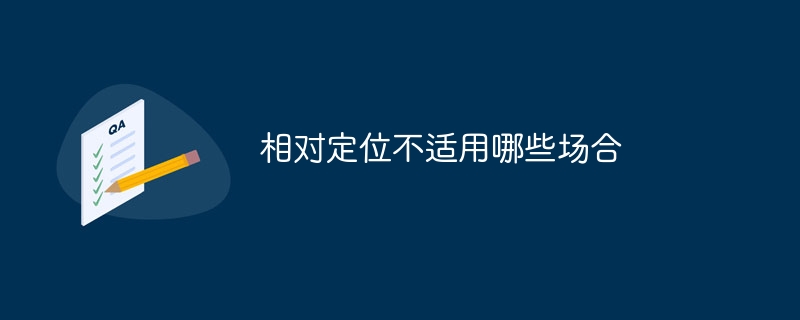相对定位不适用无需精确位置信息、无法获取定位设备、定位精度要求不高、环境条件限制、隐私和安全问题、定位技术成本过高等场合。详细介绍:1、无需精确位置信息:在某些应用场景中,无需精确确定位置信息,例如简单的数据记录、文本处理等;2、无法获取定位设备:在一些场合下,可能无法使用定位设备,如室内定位、深海定位等;3、定位精度要求不高:在某些应用场景中,对定位精度要求不高等等。

本教程操作系统:windows10系统、Dell G3电脑。
相对定位主要适用于需要确定物体或个体在地球上的精确位置的场合,以下是一些相对定位不适用的场合:
无需精确位置信息:在某些应用场景中,无需精确确定位置信息,例如简单的数据记录、文本处理等。
无法获取定位设备:在一些场合下,可能无法使用定位设备,如室内定位、深海定位等。
定位精度要求不高:在某些应用场景中,对定位精度要求不高,例如大气污染监测、森林火灾监测等。
环境条件限制:在某些环境下,如极端温度、高湿度、电磁干扰等,定位设备可能无法正常工作或产生误差。
隐私和安全问题:在某些场合,如军事设施、敏感区域等,可能不允许使用定位技术。
定位技术成本过高:在某些应用场景中,使用相对定位技术成本过高,不划算。
总之,在无需精确位置信息、无法获取定位设备、定位精度要求不高、环境条件限制、隐私和安全问题以及定位技术成本过高等场合,相对定位可能不适用。在实际应用中,需要根据具体需求和条件来选择合适的定位技术。
以上就是相对定位不适用哪些场合的详细内容,更多请关注php中文网其它相关文章!

每个人都需要一台速度更快、更稳定的 PC。随着时间的推移,垃圾文件、旧注册表数据和不必要的后台进程会占用资源并降低性能。幸运的是,许多工具可以让 Windows 保持平稳运行。

Copyright 2014-2025 https://www.php.cn/ All Rights Reserved | php.cn | 湘ICP备2023035733号